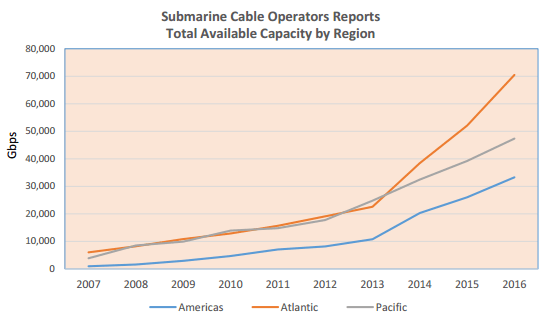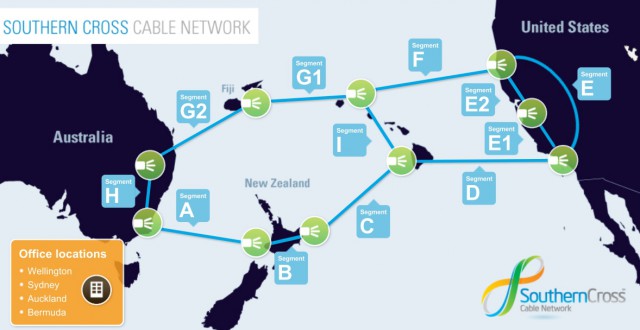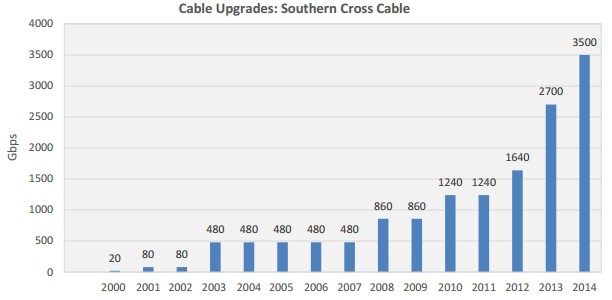 Overall submarine cable capacity, which supports a substantial amount of international Internet traffic, has grown around 36% per year for 2007-2014 and is expected to grow around 29% for 2014-2016. But traffic planners are confident the traffic growth will be easily accommodated over existing submarine cable circuits.
Overall submarine cable capacity, which supports a substantial amount of international Internet traffic, has grown around 36% per year for 2007-2014 and is expected to grow around 29% for 2014-2016. But traffic planners are confident the traffic growth will be easily accommodated over existing submarine cable circuits.
A new U.S. International Circuit Capacity Report from the International Bureau of the Federal Communications Commission details the total amount of capacity available between the U.S. and any foreign point. That data helps traffic planners maintain suitable Internet traffic capacity before international data traffic jams emerge. The report shows plenty of capacity remains available to handle sustained Internet traffic growth between North America and other countries around the world. Only the Pacific region, encompassing Australia and New Zealand, shows the potential for a future capacity crunch if more cable capacity isn’t introduced in the coming years.
Submarine cables laid more than a decade ago are showing vast capacity improvements, not because new fiber is being laid underwater, but because of developments in submarine cable technology.
“The technology standard has evolved from 280Mbps per pair (TAT-8 cable) in the mid-1980s, to 5Gbps (TPC-5) in the mid-1990s, to 10Gbps in 1998,” says the report. “Since 1998, the 10Gbps fiber pair has been the standard for all new cables. There are plans to deploy 40Gbps or even 100Gbps fiber pairs. Moreover, the use of Wavelength Division Multiplexing (WDM) technology can multiply the capacity from one pair to multiple pairs depending on the wavelength (or color) of the cable.”

One exceptional example comes from the Pacific region, where Internet traffic has exploded. The Southern Cross cable, which connects Australia, New Zealand, Fiji, Hawaii, and the United States, began service in 2000 offering a total capacity of 20Gbps. Those behind the project envisioned that technological advancements would eventually allow the cable to achieve a total of 120Gbps of “fully protected capacity.” They vastly underestimated what ingenuity in data transmission would bring just 16 years later.
 Southern Cross engineers are now deploying circuits capable of 40 and 100Gbps technology, bringing Southern Cross cable’s total available capacity to more than 12Tbps (12,000Gbps). Every upgrade was conducted at the cable station with zero new fiber pairs laid in the water. Other undersea cable operators are initiating similar upgrades, providing exponentially greater capacity at a minimal cost.
Southern Cross engineers are now deploying circuits capable of 40 and 100Gbps technology, bringing Southern Cross cable’s total available capacity to more than 12Tbps (12,000Gbps). Every upgrade was conducted at the cable station with zero new fiber pairs laid in the water. Other undersea cable operators are initiating similar upgrades, providing exponentially greater capacity at a minimal cost.
The report found the most popular destination for U.S. international undersea cables was Colombia, which hosts eight. Japan and the United Kingdom are each reached by seven U.S. cables. Five cables each reach Panama, Brazil, and Venezuela, and Mexico and Australia have four each.
The most aggressive capacity upgrades are scheduled for the Atlantic region, mostly to support increasing traffic from Europe, the Middle East, and especially Africa. The Pacific region, in contrast, has just 13.3% non-activated capacity, possibly demonstrating a need for new cable capacity.


 Subscribe
Subscribe
facts thanks for showing that bandwidths are not infinite. (we all know data is, want some?) end to end. there rules vary, all links in the web matrix have limits. or are broken today, and traffic must be rerouted, and impacting others. if fact that is the reason for TCP-IP and the original ARP net to go around bomb craters. (use a matrix , system) it was for war related reliability then. traffic. (basics) see overload. https://en.wikipedia.org/wiki/Web_traffic the web is not some homogeneous system, not at all. ( like 2 tin cans and string) nor is it owned by one… Read more »